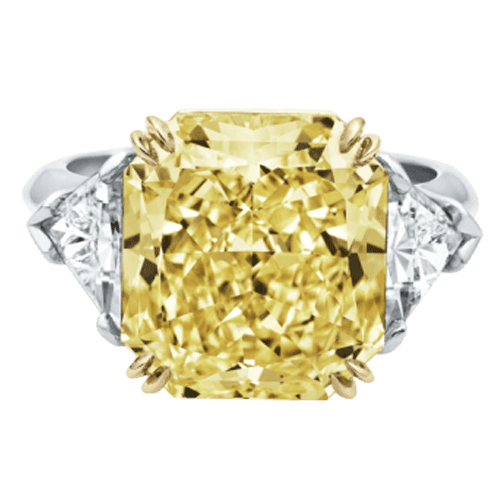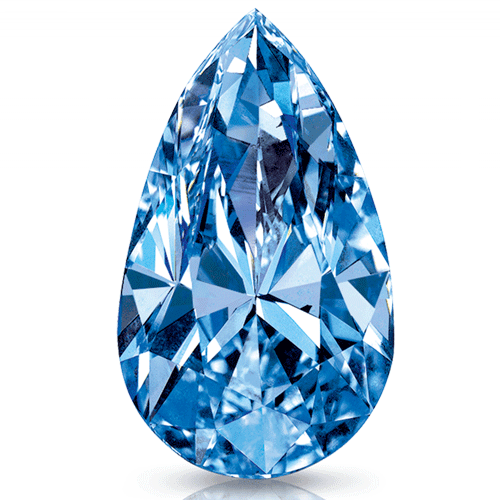Why buy a diamond? It’s a question most would answer quite simply: as a symbol of love, either to a special person in one’s life or as a beautiful reward to oneself. In the pursuit for a purchase that encapsulates the emotion of love, a diamond is one tangible way to express intangible qualities, such as beauty, rarity and eternity.
That’s the way the diamond industry has operated for generations and also why diamonds have captured the imagination of consumers and their chequebooks. Yet increasingly, diamond is being marketed as an ‘investment’, particularly the rarest varieties in terms of size and colour. Diamond’s attractiveness to investors is based on the relative buoyancy and consistency of the diamond market compared to other investment channels such as shares and property.
 |
| Above: Harry Winston |
As headlines abound about record-breaking jewellery auctions, breathtakingly large bids at the Argyle Pink Diamond Tender and, more recently, panic about diminishing supply, it can be easy to lose sight of the unique risks of diamond as an investment.
A question of colour
When considering investing, it’s important to distinguish between the colourless (‘white’) diamond market and that of natural fancy colour diamonds.
Unlike other gemstones, white diamonds can be likened to, and tracked as, a commodity; they are prone to fluctuations in supply, demand and price, and therefore prime for speculation. Exemplifying this, white diamonds have seen prices collapse across all sizes and grades over the past year.
Alan Bronstein, president of the Natural Color Diamond Association, believes this does not make white diamonds an appealing investment option
“A private individual has very limited options for selling or achieving liquidity on a downward cycle, which we are in now and that the trade is experiencing for the last two years,” he says. “No one can predict if and when this trend will change so how can you prepare for the moment of liquidation? And if traders, who make their living in this volatile market of fluctuations, get trapped in the unpredictable cycle, what chance does a private individual have?”
In order to halt the current downturn of the market, Bronstein believes the industry will tighten supply in order to stabilise prices. Indeed, this trend that has already begun with De Beers.
The diamond behemoth recently slashed its production targets for the second half of 2019 following a 50 per cent drop in rough diamond sales for its sixth cycle compared to the same period last year. Russian mining giant Alrosa, which is the world’s largest diamond producer by volume, has also begun reducing supply.
Bronstein also points out that certain extremely large diamonds have not been absorbed into the market as quickly as in previous years.
“There is, relatively, more availability and the demand at this moment cannot keep up with the supply,” he explains. Indeed, as technology has improved – both in diamond discovery and excavation – increasing numbers of large diamonds have flowed into the market.
Canadian company Lucara Diamonds has unearthed two diamonds of more than 1,000 carats in just the past four years at the Karowe mine in Botswana, while Australian miner Lucapa has unearthed 13 diamonds of more than 100 carats since 2015 at its Lulo alluvial mine in Angola. Both miners used Tomra XRT optical sorting technology.
Despite the uncertainty in the market, pricing authority Rapaport includes an Investment Diamond Certificate as one of its advertised services.
The company claims the certificate “provides absolute confidence and assurance of quality and added value” and that “Rapaport certified diamonds maintain their market value, making them ideal for investors, looking for portfolio diversification.”
Portfolio diversification is a trend noted by Ari Taibel, gemmologist and director of Australia’s leading fine jewellery and gemstone auction house First State Auctions.
“Many auction buyers have an investment angle when buying diamonds as well as fine gemstone jewellery. I believe they see diamonds as a very compact and tangible store of wealth,” Taibel explains. “One big diamond investor told me he has become a big investor in diamonds and coloured gemstone jewellery since the GFC [global financial crisis of 2008].
“Over the last 10 years, we have seen fancy colour diamonds as the best-performing class of diamond,” he adds. “Diamonds with a reputable laboratory report like GIA or GSL are always preferable as these are very highly regarded by investors.”
Yseult de Crombrugghe, project manager Langerman Diamonds, which deals in natural, fancy-colour diamonds of all hues, says that colour diamonds are appealing due to the low volatility in the market.
“High-quality diamonds are more and more considered by savvy investors as a strong and wise long-term investment. Scarred by the Financial Crisis and fearful about volatility, Millennials are looking for unique and alternative sustainable investments. Fancy colour diamonds are one of those – they are amongst the least volatile investments possible. Additionally, we have noticed a new trend for fancy colour diamond collections.”
The incredible price rise of pink diamonds is impossible to ignore. According to the Fancy Color Research Foundation, which tracks pricing and auction results for natural fancy colour diamonds, pinks have averaged price-per-carat growth of 12.1 per cent per year from 2005 to 2019; however, this figure is an average and includes outlier auction pieces that have fetched up to $US2 million per carat.
Arnaud Soirat is chief executive of copper and diamonds at Rio Tinto, which owns Argyle in West Australia, the world’s largest pink-diamond mine. Soirat told The Age, “If you look at the evolution of the price over the past 20 years the price has increased by 500 per cent. Every year the price increases by a double digit number; if you compare that to the stock market that’s significantly higher.”
Those prices are predicted to rise even further with the imminent closure of the Argyle mine in 2020, which is reported to account for 90–95 per cent of the world’s pink diamonds, as well as a significant portion of yellows and ultra-rare reds.
Less than 1 per cent of all diamonds mined globally have colour.
As a result, it’s no surprise that specialist companies such as the Sydney-based Australian Diamond Portfolio have emerged to assist prospective buyers in acquiring pink diamonds “like any other traditional asset”. The service provides “sourcing, buying, storage, and later selling” of pinks, while claiming the diamonds offer “insulation from traditional financial markets”.
The business’ website also prominently features Mark Bouris – CEO of the ASX-listed Yellow Brick Road Group and star of reality TV shows The Apprentice and The Mentor – explaining the benefits of pink-diamond investment.
Yet, while industry experts acknowledge the historically high prices of pink diamonds, they caution against viewing them as a tool to increase personal wealth – especially since the concept of value is not intrinsic, but relative, and driven by trends.
“Even as they are getting more fashionable, most people know very little about colour diamonds and will only refer to ‘headline’ diamonds, namely blue, pink and yellow,” de Crombrugghe says, “but there is a myriad of natural, fancy colours. Langerman Diamonds’ inventory includes over 300 colours! Some, such as orange and green, are largely undervalued and will certainly rise in value in coming years.”
Bronstein goes further: “Just like artwork, the value [of natural fancy-colour diamonds] is totally subjective – you can have three people offering $10 million, $12 million or $15 million, but the seller wants $20 million. The fact is, they are all correct. The ‘value’ is what somebody’s willing to pay.”
 |
| Above: Graff Diamonds |
He also cautions against buying on certification alone: “I have heard dozens of horror stories about individuals who were baited into investing and were sold the worst stones with highly-praising lab reports. Even holding for five to 10 years as an investment, they had no place to get liquidity but an auction house and only recouped 10 to 20 per cent of their initial investment. “The best one can offer as a statement on fine gems and jewellery is that the past has shown that certain fancy colour stones have a faster liquidity and potential rise in value,” Bronstein adds. Meanwhile, Taibel differentiates diamonds from other asset classes.
“Diamonds are an excellent long-term investment but not in the same way as property and shares. The main differences being that no income is earned from holding a diamond, there are higher commissions in trading diamonds compared to shares and property, and pleasure is derived from wearing the diamond.”
Taibel emphasises that diamond holds its value over time better than some other luxury purchases: “Diamonds purchased at retail have an instant depreciation in value like a new car being driven out of the dealer’s lot; however, unlike a car, they will not continue to depreciate – depending on the diamond market. In summary, a diamond is a ‘good investment’ when purchased astutely and when pleasure is derived from it.”
George Cochrane, a certified financial advisor with more than 35 years experience and a prominent financial journalist, says long-term investing should start with a ‘widespread portfolio’.
“Place your eggs in different baskets – for the not so rich, I would stick to the basics of shares, property and bank deposits until you feel your current rainy-day needs and your future retirement needs are covered,” he says. “Once you feel you have these bases covered, you can expand your horizons into collectibles such as art and gems and coins.”
He adds: “The value of each [art, gems and coins] arguably has as much relation to marketing as to any inherent value. Further, these sectors probably have greater retail selling costs than any other asset so any ‘market value’ must be reduced by whatever premium the dealer or auctioneer demands.”
When considering a diamond purchase, particularly of natural, fancy-colour diamonds, the most important thing is to consider the beauty of the stone and one’s personal connection to it.
“Unlike for colourless diamonds, the baseline for pricing is not only a ‘4 Cs’ grading report linked to a benchmark but mainly the rarity and the beauty of the stone,” de Crombrugghe explains. “It’s all about the unique colour viewed face-up – the scarcity of the hue, the tone and undertones, the saturation, the cut, the weight, the provenance and the demand will determine the value. Moreover, as it is for investments in unique paintings or artworks, it must be love at first sight.”
For Bronstein, it’s a simple equation: “Purchase of a natural colour diamond should be based on three things only: affordability, beauty and desire.”
Even as the market is gripped by pink fever, it remains true that the only valuable quality in a diamond is what the owner sees in it. And when that quality is beauty, love and emotion, it has something more than value: it has meaning.